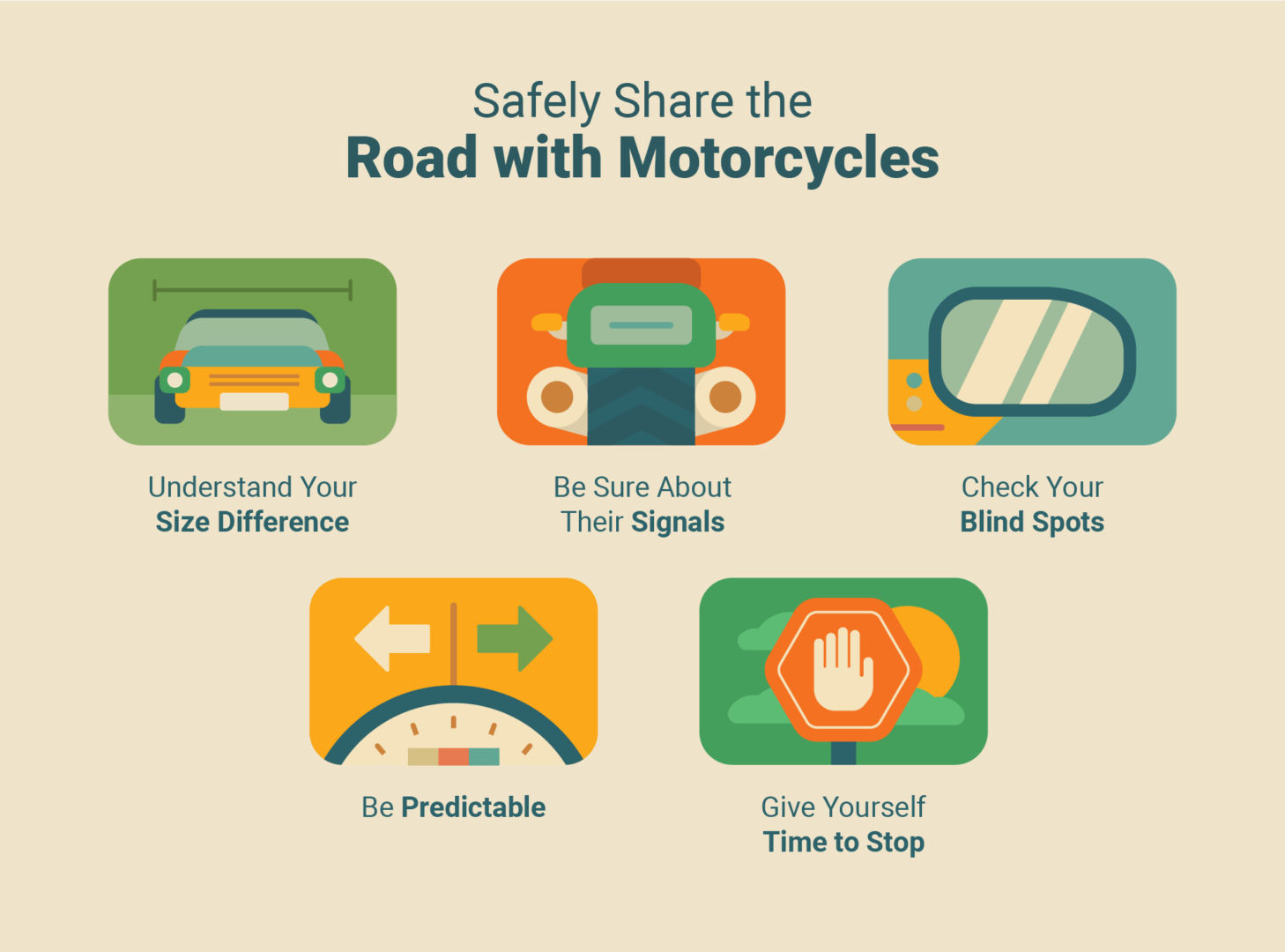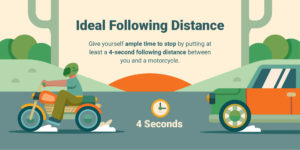When roads are clear, motorcyclists are ready to hit the road. This means that drivers of both cars and motorcycles need to be more alert about sharing road space. While motorcyclists have to be extra vigilant when it comes to driving on city roads and highways, car drivers share an equal responsibility to minimize the danger of motorcycle accidents.

Here are the main points to check for when it comes to cars and motorcycles sharing the road:
Double-check those blind spots
Motorcycles can be hard to see – they’re a lot smaller than other vehicles, which means they’re easy to miss. Doing a double-check on blind spots and looking in mirrors before merging or doing a lane change can prevent accidents.

Leave plenty of space between cars and motorcycles
When slowing down, many motorcyclists downshift to reduce speed without using their brakes or turning on their brake lights at all. Leaving a following distance of at least 4 seconds gives car drivers enough time to react to the motorcycle in front of them. Leaving ample space is also advisable when driving in bad weather, when motorcycles are much more affected by wet road conditions than cars.

Use extra caution when turning left
Intersections are hazardous for motorcyclists at all times and even more so when there’s a lot of traffic. Drivers should scan the road carefully before turning, particularly when turning left, to ensure they’re not turning in front of an oncoming motorcycle.
Pay attention to motorcycle turn signals
Many motorcycles have turn signals that don’t cancel automatically after making a turn. If a motorcyclist has a turn signal on, it may mean that they’ve forgotten to turn it off and they’re not turning at all. Vehicle drivers need to pay attention to these signals, making sure their own signal is on and waiting until they’re sure of the motorcycle’s intent before making a lane change or merging.
Motorcyclists also need to do their part when sharing the road with larger vehicles. Here are some tips for riding safe:
Let yourself be seen
Because of your size it can be easy for even vigilant drivers to miss seeing you. So, it’s up to you to make yourself as visible as possible. One way to do this is by wearing bright clothing that’s going to get you attention and make you stand out. Choose brightly colored jackets and vests and a light-colored helmet. Add reflective material or extra lights to your bike, especially if you’re riding in low-light conditions.
Stay visible in lanes
Choose lane positions that put your bike into clear view of drivers, so you’re not hidden in their blind spot. One of the safest positions is in the leftmost side of the lane close to the dotted line. When driving in heavy traffic, reduce your speed and don’t tailgate. You need to be prepared for any sudden stops from the vehicle ahead of you.

Be prepared to ride
Before you get on the road, make sure your motorcycle is fit for riding by doing a pre-check. Avoid the risk of riding and encountering a problem by checking the following:
- Controls – Check to make sure that headlights, taillights, and signals are all working.
- Tires – Look for signs of wear and tear that could be hazardous, such as tire bulges or cracks. Check the air pressure – low tire pressure can cause a blowout.
- Fluids – Check to make sure there’s no sign of leaking fluids around your bike. Brake, coolant, and oil fluids should be checked every week.
- Mirrors – Check the mirrors for cracks or any loose joints or mounts. When adjusted, you need to ensure mirrors stay where you set them when riding.
- Brakes – Get on your bike and rock it while holding the front and back brakes. You want to be sure both the brakes and shocks are in good working order.
Ride awake and sober
Never ride your motorcycle when you’re drowsy and tired. Fatigue can impair your ability to react quickly and responsibly. Make sure you’re awake and alert before you start to ride. And never ride when under the influence of drugs or alcohol.
By following the guidelines and tips above, both vehicle drivers and motorcyclists are doing what they can to minimize accidents while sharing the road.
Heidi Thiel is a writer and content creator for the transportation and travel industries. You can currently find her work over at CarRentals, and you can connect with her on LinkedIn.






